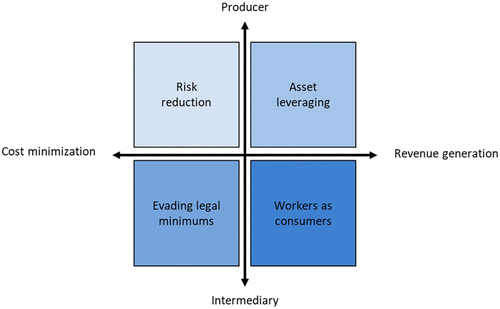 by Heather Sanders
by Heather Sanders
Laya Behbahani is a labour scholar and advocate against human trafficking, forced labour and slavery. She is also a lecturer in Labour Studies, the director of the Student Experience Initiative and PhD student in the School of Communication at SFU, where she received a 2020 Pierre Elliot Trudeau Foundation Scholarship to support her studies. Her recently published research is a collaboration with Andrew Crane from the University of Bath, Genevieve LeBaron from the University of Sheffield, Kam Fung from York University, and Jean Allain from Monash University. Their paper, Confronting the Business Models of Modern Slavery, outlines the phenomenon of forced labour and exploitation in several industries across the United Kingdom and reveals how slavery continues to flourish in the modern economy.
“It was a very interesting time to conduct this research,” says Behbahani, whose fieldwork began in 2013. The government of the U.K. would soon thereafter pass the 2015 Modern Slavery Act – a framework for identifying victims of modern slavery. “It was a very political issue in the U.K., because of the potential of criminalizing victims of unfree labour, including those that had been trafficked or exploited as workers. The concern was that it would make it harder for victims to come forward, and it wasn’t necessarily designed in the interest of those who find themselves being exploited. It did however, open a discussion of what constitutes modern slavery.”
Defined as “situations of exploitation that a person cannot refuse or leave because of threats, violence, coercion, deception, and/or abuse of power,” by the International Labour Organization, it is estimated that tens of millions of people are victims of modern slavery every year. Yet, despite its widespread presence, little is known about how modern slavery works from a business perspective.
Slavery from a historical perspective
The researchers acknowledge that much scholarship has been written about the business model of “traditional slavery” in the Antebellum U.S. South. Traditional slavery – now recognized as wrong and inhumane – was productive, profitable, and tolerated as a necessary social and economic institution protected within the law and customs of the time. It involved a complex network of producers, intermediaries and beneficiaries – from slave-traders to enforcement to merchants and it was international in scale. Dismantling traditional slavery was a monumental task given its profitability and reach.
Today, the term “modern slavery” refers to some of the most extreme forms of exploitation. While similar to traditional slavery, modern slavery now exists without the legal status of traditional slavery. Given that much is known about the business model of traditional slavery, the researchers wanted to better understand the business models of modern slavery and determine what novel distinctions have emerged that need to be understood and disrupted. They discovered that in terms of its business model, modern slavery still relies heavily on two key features: economic rationale and a reliance on coercion.
The four business models of modern slavery
The researchers focused on two legal business sectors, food and construction, and one illegal business sector, cannabis cultivation, to explore different business models across formal, informal, and criminal modern slavery enterprises. Looking at modern slavery from these dimensions revealed four business models that are distinct in comparison to the business of traditional slavery: risk reduction, asset leveraging, evading legal minimums, and workers as consumers.
Risk reduction involves exploitation of workers to minimize the chances that producers will be caught in illegal businesses or practices. In legitimate businesses, pressures to reduce labour costs along the supply chain can lead producers to engage in illegal labour practices to capture more value from workers, such as arbitrary pay deductions, excessive hours, safety violations, or paying below the minimum wage. The pressure to keep costs low and hide illegal practices creates a vicious cycle of exploitation and concealment. These organizations also deliberately recruit vulnerable workers, such as illegal immigrants, non-English speakers or minors who may be unaware of or unable to defend their rights.
Asset leveraging refers to activities that generate additional revenue streams, for example, charging workers for lodging, tools, or transportation or collecting recruitment fees. Some organizations may pay a legitimate wage, but then deduct excessive fees. This enables them to operate within legal boundaries while generating extra revenue. Another tactic is to use indebtedness or debt bondage – promising to pay for workers’ documentation and immigration, and then not offering sufficient wages to pay off these costs. To maximize their returns, perpetrators impose obstacles to workers leaving, such as threats, withholding wages, or confiscating documents. Archival testimony from Latvian farm workers in the U.K. described how their supervisors took away their passports so they were unable to leave.
In the evading legal minimums model, the key driver is the need to reduce labour costs by labour market intermediaries including recruitment agencies, labor providers, and even gang leaders. To increase their profit margins, some agencies minimize costs by outsourcing or subcontracting recruitment, and the more informal the arrangement, the more likely the use of vulnerable, foreign, migrant, or smuggled workers. Another tactic is hiring through employment schemes that label workers as self-employed, responsible for their own costs and taxes. In this model, the enterprise is able exploit regulatory loopholes, while evading legal requirements.
In the workers as consumers control model, the intermediaries generate revenue by charging for services such as accommodation and food, as well as transportation or the use of company tools. Similar to the asset leveraging model, this business model generates income for the intermediaries while ensuring workers are indebted to them. Not only do these workers arrive in the U.K. owing money to their recruiters, they are often underworked, and accrue more debt than they are able to repay. This becomes a vicious cycle of indebtedness and entrapment, one of the most extreme forms of exploitation and hardship identified by the research.

Modern slavery in labour-intensive industries
Laya Behbahani specifically investigated the cannabis sector and travelled to various jurisdictions across the U.K. to conduct in-person interviews with police agencies. As she completed her research a picture began to emerge at how organized crime exploited and coerced labourers – and how the victims were caught up in up in justice system that didn’t recognize their situation as exploited or trafficked workers, since cannabis is illegal to possess, grow, distribute or sell in the U.K.
The perpetrators were typically reported to be organized criminal gangs, usually of Vietnamese origin. Behbahani found that the victims would usually be workers of the same nationality or ethnicity who were trafficked in from Asia. She found a trend to use people who looked young in appearance, who were coached to claim they were minors in order to avoid criminalization and deportation.
Behbahani has several recommendations to prevent the exploitation of workers, and enable victims of modern slavery to seek justice. The first would be to disengage anti-human trafficking laws and policies from immigration laws. “Human trafficking needs to be approached as a human rights issue, rather than an immigration issue. I think above all this needs to be more about human rights and not about criminality.” she states.
Specifically with regards to policies such as U.K.’s National Referral Mechanism to identify victims of slavery, Behbahani recognizes the burden this places upon victims. “Many are traumatized, are victims of PTSD and have been threatened if they come forward to authorities.”
“I also think corporate actors need to be held accountable,” she says. “One of the main goals of our research was to understand how perpetrators are linked with other business actors through the supply chain – so they need to be aware and be involved in these conversations.”
Behbahani also recommends an overhaul of temporary foreign worker programs. “Many countries have these migrant programs, from Canada’s agricultural workers to the Gulf State’s kafala system – where I do research – whereby there is a regular supply of migrant workers that are deployed to the Middle East to undertake low-wage work to keep up with the extreme rate of development and capital accumulation in the region.”
She referenced the worker-based human rights organization, the Coalition of Immokalee Workers, who has been recognised for their achievements in anti-slavery efforts, and developing a worker-led, market-enforced approach to the protection of human rights in corporate supply chains.
“In a perfect world,” says Behbahani, “we would see the workers themselves granted the power to inform the policies and processes that affect them in the contemporary global political economy.”
SFU's Scholarly Impact of the Week series does not reflect the opinions or viewpoints of the university, but those of the scholars. The timing of articles in the series is chosen weeks or months in advance, based on a published set of criteria. Any correspondence with university or world events at the time of publication is purely coincidental.
For more information, please see SFU's Code of Faculty Ethics and Responsibilities and the statement on academic freedom.